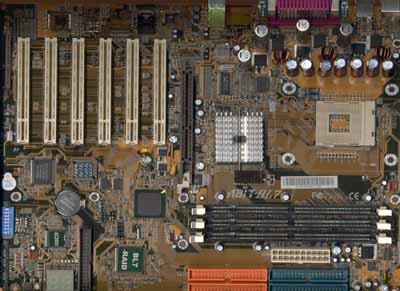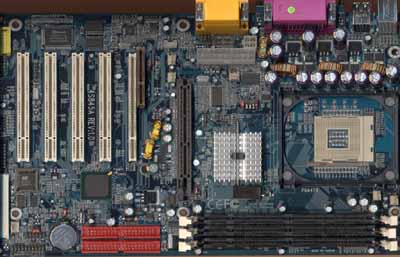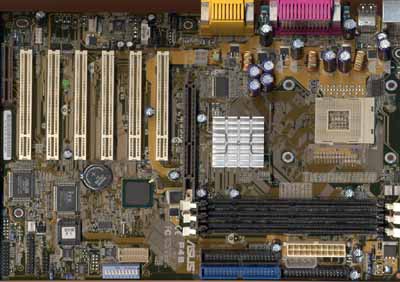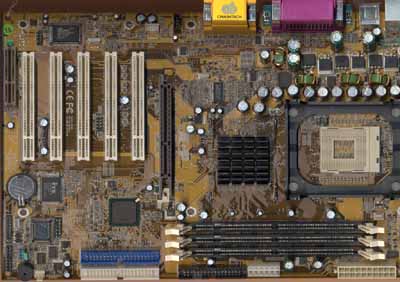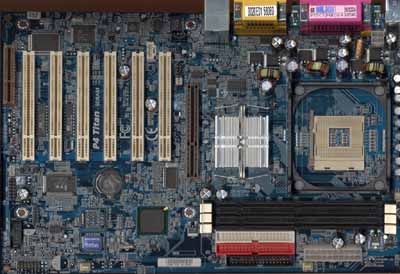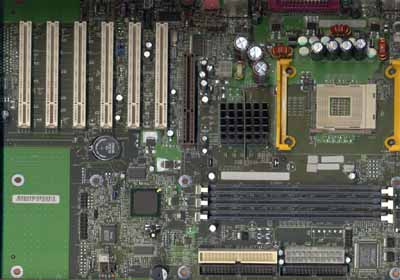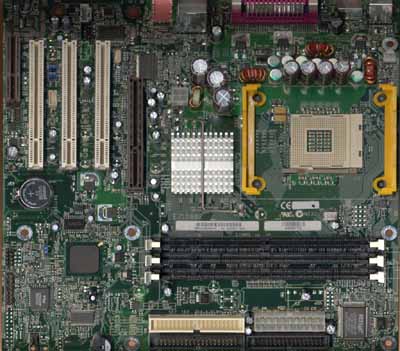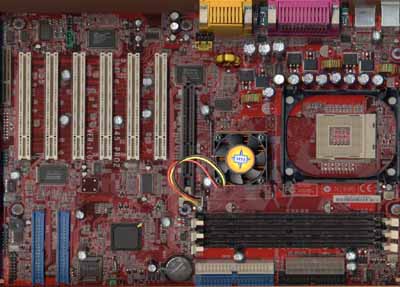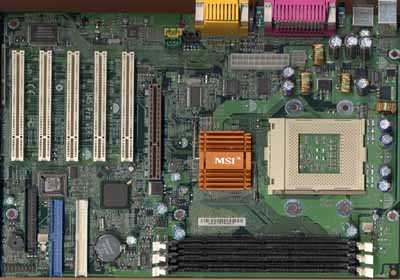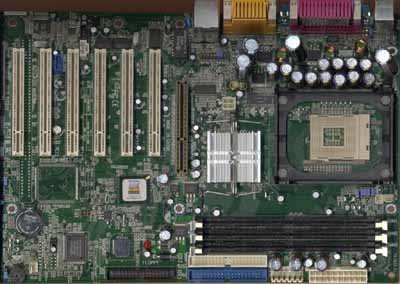
Original Link: https://www.anandtech.com/show/826
Intel 845 Chipset Review & Motherboard Roundup: September 2001
by Anand Lal Shimpi on September 11, 2001 10:38 AM EST- Posted in
- Motherboards
In spite of the fact that we, along with a number of other sites, have already brought you performance figures on Intel's 845 chipset, and in spite of the fact that boards have been on sale for weeks now, today is the official launch date for the i845.
For those of you that aren't familiar with it, the i845 was formerly known as the Brookdale chipset. The 845 is a Pentium 4 chipset and mainly differs from its older brother, the i850, in its support for regular SDRAM. As we mentioned in our Computex 2001 Coverage, the 845 chipset actually features a memory controller that supports both regular SDRAM and DDR SDRAM. Unfortunately, Intel is only allowing motherboard manufacturers to release boards with PC100/133 SDRAM support.
Although we've heard many explanations for the reason why Intel would wait until 2002 for the release of the DDR 845 motherboards, a big reason seems to be that Intel honestly does not see much room for DDR in the desktop market. Intel's memory roadmaps have consistently shown PC133 SDRAM on the low end and RDRAM servicing the mid-range to high end of the market. The only room for DDR with the Pentium 4 in Intel's mind is in the mid-range of the market if RDRAM is unable to come down enough in pricing. With the current pricing on RDRAM, it is doubtful that Intel even sees a reason to go forward with allowing a DDR 845 motherboard to be released.
In many ways it's a shame that the first 845 motherboards don't offer DDR SDRAM support, since the chipset itself is one of Intel's most advanced solutions, ever.
Deeper Buffers & Write Cache: Perfect for DDR
The i845 Memory & Controller Hub (MCH) is Intel's first 0.18-micron MCH. Even the recent i850 MCH was built on a 0.25-micron process like the earlier 815 and 820 chipsets. The fact that the MCH is a 0.18-micron solution means lower manufacturing costs as well as a very small die. As you can see from the below picture, the MCH itself is the smallest we've ever seen out of a current generation chipset.
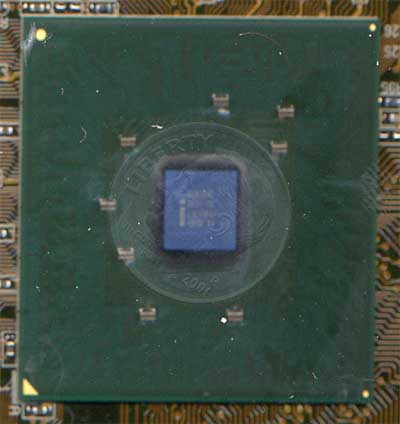
The watermark of a US dime gives you an idea of how small the core of the chipset
is.
The 845 MCH is also Intel's first chipset to use a Flip Chip BGA packaging for the chip itself. This improves heat conductivity between the MCH and its heatsink which is required for proper operation. With such a small die surface area, a good heatsink and mounting mechanism is necessary to conduct heat away from the chip. The MCH doesn't get excessively hot, but a heatsink is still required.
Had the 845 been produced on a 0.25-micron process, it would be almost 50% larger than its current size; the savings offered by Intel's very mature and very advanced 0.18-micron process are evident in some of the features that were included into the MCH.
The first major improvement is the inclusion of a write cache. This is the first SDRAM chipset from Intel to employ a write cache on the MCH itself; the i850 and i860 both had similar write caches. It should be obvious by now that today's CPUs run much faster than the memory they have to store data in. When the Pentium 4, for example, goes to write data to memory, it must send the write command and data through the FSB, into the MCH, out through the memory bus and, finally, to the memory itself. In order to sustain maximum bus efficiency, these writes would normally be buffered so that the Pentium 4 could go back to work as soon as possible. The next step beyond a simple buffer is an intelligent memory storage that would actually cache the writes and act as a very small L3 cache on the MCH itself. Now, we're still not dealing with a full fledged read/write L3 cache on the MCH itself, but we're getting there. This is made possible by the small 0.18-micron die. It wouldn't be too surprising to see the transition to 0.13-micron MCH/North Bridges met with much larger read and write caches, eventually bringing us to L3 caches on the chipset for mainstream solutions.
The second major feature of the 845 is its very deep buffers. We praised the P4X266 chipset for being buffered deeply enough to take advantage of the greater transfer rates that DDR SDRAM offers over regular SDRAM, which VIA was used to implementing on chipsets; the i845 is actually buffered even deeper. The deeper your buffers, the higher your sustained memory bandwidth can be. This comes courtesy of the maximum In Order Queue (IOQ) depth level of 12 on the 845 vs. 8 on the i850 and on the P4X266.
Before you get too excited about these two features, you must realize that, although they help to make very efficient use of the available memory bandwidth, they don't get around the fact that the 845's currently only has PC133 SDRAM at its disposal. So although the combination of an intelligent write cache and deeper buffers gives the 845 the leg up on the P4X266 in terms of efficient bandwidth usage, the P4X266 still has twice as much bandwidth at its disposal. Then, why on earth would Intel outfit the i845 with such an advanced MCH?
For one, the Pentium 4 at 1.5GHz and above needs at least 1.5GB/s of memory bandwidth to perform close to its peak. Unfortunately, even at 100% bus utilization (not real world by any means) PC133 SDRAM can only provide 1.06GB/s of memory bandwidth.
The second possibility would be that the i845 was to pave the way for an extraordinarily high performing DDR SDRAM solution. Based on the current specifications of the 845, it would not be surprising if a DDR266 (PC2100) version of the chipset outperformed the i850 with today's Pentium 4s. We have already seen that the P4X266 can come within a few percentage points of the i850; even deeper buffering and an intelligent write cache could place DDR a bit outside of Intel's desired positioning for it. Fortunately, for Intel (but unfortunately for the consumer), the 845-D (DDR) is set to debut with only DDR200 SDRAM and not DDR266. Update: Intel has confirmed that in Q1-2002 they will debut with both DDR200 and DDR266 support.
"A Stable Platform"
Because of the limited memory bandwidth of the current i845 motherboards, Intel
is positioning the solution as the next-generation stable platform for businesses.
The generation that this platform will be replacing is, of course, the age-old
BX chipset; it isn't a surprise that motherboard manufacturers in
Intel is proclaiming the i845 to be a stable platform for businesses to upgrade
to. Obviously, a biased statement since Intel does want to push Pentium 4 sales,
but as we heard from manufacturers in
Although the performance enthusiast in us all will cringe at the sight of only being able to use PC133 SDRAM, it is embraced by the corporate/IT market that the chipset is targeted at because of its nature as a tried and true solution. We all know that both DDR SDRAM and RDRAM are "tried and true" solutions as well, but convincing the manager of an IT department that is thousands strong is a bit more difficult. The target market for the i845 wants a solution that's been around for a while, not necessarily one that's the highest performing.
With the 0.13-micron Pentium 4 (codename: Northwood) due to receive a 512KB L2 cache, the Pentium 4's dependency on a high-speed memory bus for simple office applications will decrease tremendously. This is because more data is able to be stored in the processor's L2 cache, eliminating the need to even traverse the memory bus after it’s stored in cache to get to the data when used.
The chipset also supports up to 3GB of PC133 SDRAM; 6 times as much as the older i815 chipset. Why compare it to the Pentium III's 815 chipset? Because that is the market that Intel is targeting this solution at. The businesses that used to be running on Pentium III/815 platforms will be pointed at the Pentium 4/845 as the solution to upgrade to. The Pentium 4/845 combination, while unable to outperform the Athlon, can offer a significant performance boost over the platform that it is designed to replace: the aging Pentium III/815.
With support for so much memory, the 845 could also be seen as an entry level webserver platform as well.
The one role that the 845 will not play is the role of the high performance platform; for that role, you'll have to go to the 850 or VIA's P4X266.
Already a Mature Platform
Since we've already provided chipset performance data in our P4X266 review, we decided to turn this article into an introduction of both the chipset and a roundup of motherboards based on the 845.
Intel 845 motherboards have been up and running for months now, which is one of the reasons why you've seen benchmarks for the platform so early.
With the exception of one motherboard, every 845 motherboard we received worked flawlessly.
One of the biggest problems we've encountered with motherboard reviews in the past has been stability/reliability testing. Anyone familiar with the motherboard industry and how motherboards are made knows very well that you cannot accurately gauge stability of a motherboard through the use of any sort of software testing on a single motherboard. True stability testing requires a very large sample size of motherboards and much more intensive procedures, which make rating stability/reliability very difficult to perform in a review. The most we can offer is an indication of how the motherboard performed in our tests, which we have tried our best to do.
In order to put a greater stress on the motherboards themselves during the testing procedure, we modified our usual test bed a bit. Instead of testing with 128MB or 256MB of PC133 SDRAM we used a full 384MB and set the memory timings using the modules' serial presence detect (SPD) logic. The reason for using 384MB is so we could fill up all of the memory banks on the i845 motherboards (all of the boards had three memory slots) with a reasonable amount of memory that you could expect to see in this type of a system. We used the very popular Crucial PC133 SDRAM modules (all three were identical) that featured CAS2 Micron -7E PC133 SDRAM chips.
There is no shame in on-board Sound
When AC'97 codecs first started appearing on motherboards, they were very poor in quality and CPUs weren't necessarily powerful enough to handle all of the mixing and other effects that would normally be offloaded to the DSP on a hardware sound card. What many don't understand is that the AC'97 codec on a motherboard is no different than the AC'97 codec on a sound card like the Sound Blaster Live!; it's the DSP that is the real difference between "hardware" and "software" sound. For basic sound and even just playing MP3s, the on-board AC'97 codecs on many of today's motherboards is more than enough.
The i845 motherboards present in this roundup had very solid AC'97 codecs, the best being the SoundMAX codec found on the Intel boards.
Intel's Application Accelerator
Alongside the 845 chipset, Intel is also releasing their Application Accelerator software. We brought you a quick look at this software from Computex with a promise to take a look at the software itself as soon as we returned to the lab. Unfortunately, the copy we got our hands on showed virtually no performance improvement whether it was turned on or off, confirming our suspicions that the software was nothing more than glorified IDE drivers from Intel. We gave Intel the benefit of the doubt and waited until we saw a final release before passing judgment on the software.
When we first brought you Intel's claims of the performance improvements offered by their Application Accelerator software (10% in most cases) we hypothesized that the increase was when compared to Microsoft's default IDE drivers under Windows 2000. This was indeed the case, and when compared to performance with Intel's storage/IDE drivers installed, the performance difference dropped to less than a percent. The application accelerator software did reduce boot times by around 5 – 10% under Windows 2000, but not the 50% claimed by Intel (because they were comparing to Microsoft's default IDE drivers). So is the application accelerator anything more than glorified IDE drivers? Yes and no.
The application accelerator software takes the place of Intel's previous storage/IDE drivers but it goes beyond simply providing driver support. Intel has built in software prefetch mechanisms into the application accelerator that look at data access patterns and prefetch frequently accessed data into main memory to improve performance. Since this is an IDE device driver, it only improves performance on IDE drives and even then the performance improvements can't be noticed under most conventional benchmarks. But tasks such as loading a level in Quake III Arena or unzipping a file in WinZip are sped up by a decent amount.
Intel's application accelerator can be downloaded here and is free of charge. It works with Windows 9x/Me and NT/2000/XP, although the performance improvements under XP are not as pronounced yet because of a lack of optimizations for the OS in the current driver. The application accelerator will work with any Intel 8xx chipset (for example, the 815, 845, 850, 860 but not the BX) and any CPU used with that chipset.
The Contenders
The motherboards featured in this roundup were of the Socket-423 and Socket-478 varieties, although Socket-478 boards were much more common. As we've mentioned before, Socket-478 is the way to go, and there's no reason to consider a Socket-423 solution if you are looking for a good upgrade path for the future.
The motherboards included in this roundup are (in alphabetical order):
ABIT BL7-RAID
ACorp 4S845A
ASUS P4B
Chaintech 9BJAQ
Gigabyte GA-8IDX
Intel D845WN
Intel D845HV
Iwill P4S
MSI 845 Pro2 LE
MSI 845 Pro
QDI PlatiniX 2
ABIT BL7-RAID
|
ABIT BL7-RAID |
|
|
CPU
Interface
|
Socket-478
|
|
Chipset
|
Intel
845/ICH2
HighPoint HPT370A IDE RAID controller |
|
Form
Factor
|
ATX
|
|
Bus
Speeds
|
100 - 250MHz (in 1MHz increments) |
|
Voltages
Supported
|
Auto
Detect |
|
Memory
Slots
|
3
168-pin DIMM Slots
|
|
Expansion
Slots
|
1
AGP Slot |
|
On-board
Audio
|
Avance
Logic ALC200
|
Always famous for their overclocking options and tweaker mentality, ABIT has done nothing out of the ordinary for their 845 motherboard. The BL7-RAID gets it s name from the on-board HighPoint HPT370A IDE RAID controller. As we mentioned in our IDE RAID Comparison, the real benefit of on-motherboard IDE RAID controllers is the ability to boot to your RAID array. The host CPU still handles all of the calculations involved with the array itself; the HighPoint chip serves as nothing more than a secondary BIOS that allows you to configure a RAID array and boot from it. The alternative would be to create a RAID array under the Disk Management options in Windows 2000/XP, but the problem there is that you cannot boot from the array.
ABIT's award winning SoftMenu III Jumperless BIOS setup is back, allowing for the usual set of configuration options. An interesting thing to note is that the AWARD BIOS setup featured a variety of multiprocessor settings while it's obvious that the BL7-RAID is a single processor motherboard. Could this be a sign of dual processor Pentium 4 workstations soon to come?
Continuing ABIT's recent tradition, the BL7-RAID features a power and a reset button on the board itself. This makes testing the board a lot easier as well as any other situation where you're working with the motherboard outside of your case. The board also features ABIT's two digit POST error code display for quick diagnosing of any problems you may run into. The board unfortunately won't work without power supplied to its ATX12V power connector, which is the case with almost all Pentium 4 motherboards.
ACorp 4S845A
|
ACorp 4S845A |
|
|
CPU
Interface
|
Socket-478
|
|
Chipset
|
Intel
845/ICH2
|
|
Form
Factor
|
ATX
|
|
Bus
Speeds
|
100 - 132MHz (in 1MHz increments) |
|
Voltages
Supported
|
Auto
Detect |
|
Memory
Slots
|
3
168-pin DIMM Slots
|
|
Expansion
Slots
|
1
AGP Slot |
|
On-board
Audio
|
Avance
Logic ALC100
|
While we rarely hear about the manufacturer, our own Matthew Witheiler got a chance to visit ACorp in his most recent trip to Taiwan and only had words of high praise to say about the company's quality control practices.
The 4S845A was a pretty solid board with two unique qualities. Like a few other motherboards in this roundup, the 4S845A features two BIOSes; one for backup should corruption or a bad flash render the primary BIOS useless. However, if you look at the board snap shot about you've quickly realize that there's only one BIOS on the motherboard itself.
ACorp accomplishes this by placing the second BIOS on a PCB inside what they call their Smart Panel II. The Smart Panel II is a 5.25" placeholder that mounts in a regular drive bay and features diagnostic LEDs, two USB ports, a serial port and all of the on-board audio inputs/outputs. This makes quickly plugging things into your computer much easier since you have access to these ports at the front of your case. Along with all of those ports there is also a small red button. This button allows you to switch between the primary BIOS on the motherboard and the backup BIOS located in the Smart Panel II. The beauty of this is that you can recover from a corrupted BIOS image without even opening up your case. The downside to this is, obviously, that the Smart Panel II occupies a drive bay.
The motherboard itself only has one shortcoming and that is it only features 5 PCI slots (one is shared with a CNR slot). This is compared to the 6 slots that competing boards offer; it's not a huge penalty but one worth noting.
Like the ABIT BL7-RAID, the ACorp board also had some MP settings in the BIOS. The BIOS was home to a completely jumperless configuration setup as has come to be expected of today's motherboards.
ASUS P4B
|
ASUS P4B |
|
|
CPU
Interface
|
Socket-478
|
|
Chipset
|
Intel
845/ICH2
|
|
Form
Factor
|
ATX
|
|
Bus
Speeds
|
100 - 200MHz (in 1MHz increments) |
|
Voltages
Supported
|
Auto
Detect |
|
Memory
Slots
|
3
168-pin DIMM Slots
|
|
Expansion
Slots
|
1
AGP Slot |
|
On-board
Audio
|
Avance
Logic ALC201
|
One of the most unique motherboards in this roundup, the P4B continues ASUS' long history of attention to detail. You don't find any pretty colors on this motherboard, just solid, well researched, features.
Aside from ASUS' usual stability and overclocking friendly nature, the P4B offers one feature that no other motherboard in this roundup could provide: the ability to operate without an ATX12V connector attached to the motherboard. While ASUS won't guarantee full compatibility with all power supplies, you can supply the additional +12V line to the motherboard one of two ways. You can do it through the new ATX12V power connector thus requiring a new power supply, or you can do it through a conventional 4-pin hard drive power plug mounted on the motherboard which is capable of supplying +12V as well.
As usual, the jumperless ASUS configuration is included in the BIOS setup.
Chaintech 9BJAQ
|
Chaintech 9BJAQ |
|
|
CPU
Interface
|
Socket-478
|
|
Chipset
|
Intel
845/ICH2
|
|
Form
Factor
|
ATX
|
|
Bus
Speeds
|
100 - 132MHz (in 1MHz increments) |
|
Voltages
Supported
|
Auto
Detect |
|
Memory
Slots
|
3
168-pin DIMM Slots
|
|
Expansion
Slots
|
1
AGP Slot |
|
On-board
Audio
|
C3DX
CMI8738
|
We alluded to earlier in the review that there was only one motherboard we had problems with during our testing. The Chaintech board performed very sporadically when we outfitted it with 3 SDRAM DIMMs thus populating all of its memory banks; the board was unstable and sometimes wouldn't even make it past the POST screen. The only way to solve this problem was to either remove one DIMM or run the memory clock at 100MHz; we chose the latter in order to stick with our 384MB test configuration.
There's not much else that's too special about this board; the problem we ran into was definitely unacceptable from a board among competitors that are running so flawlessly. Hopefully Chaintech will fix the problem before too many users get their hands on motherboards.
Gigabyte GA-8IDX
|
Gigabyte GA-8IDX |
|
|
CPU
Interface
|
Socket-478
|
|
Chipset
|
Intel
845/ICH2
|
|
Form
Factor
|
ATX
|
|
Bus
Speeds
|
100 - 200MHz (in 1MHz increments) |
|
Voltages
Supported
|
Auto
Detect |
|
Memory
Slots
|
3
168-pin DIMM Slots
|
|
Expansion
Slots
|
1
AGP Slot |
|
On-board
Audio
|
Creative
Labs CT5880
|
It used to be the case that Gigabyte motherboards featured virtually no tweaking/overclocking options, but that has all changed with the 8IDX, a member of Gigabyte's P4 Titan series. The AWARD BIOS setup of the 8IDX not only allows the user to adjust the FSB frequency and the voltage supplied to the CPU but also the voltage supplied to the SDRAM slots and the AGP slot. A complete 180 for Gigabyte and it's definitely appreciated, hopefully we'll see similar setup features in future Gigabyte motherboards. Another interesting feature was the ability to select what language to view the BIOS setup in: English, French, Japanese, Spansigh, German, Simplified and Traditional Chinese.
Features such as Dual BIOS and use of the on-board Ethernet complete the 8IDX package.
Intel D845WN / Intel D845HV
|
Intel D845WN |
|
|
CPU
Interface
|
Socket-478
|
|
Chipset
|
Intel
845/ICH2
|
|
Form
Factor
|
ATX
|
|
Bus
Speeds
|
100MHz |
|
Voltages
Supported
|
Auto Detect |
|
Memory
Slots
|
3
168-pin DIMM Slots
|
|
Expansion
Slots
|
1
AGP Slot |
|
On-board
Audio
|
Analog
Devices AD1885
|
|
Intel D845HV |
|
|
CPU
Interface
|
Socket-478
|
|
Chipset
|
Intel
845/ICH2
|
|
Form
Factor
|
microATX
|
|
Bus
Speeds
|
100MHz |
|
Voltages
Supported
|
Auto Detect |
|
Memory
Slots
|
3
168-pin DIMM Slots
|
|
Expansion
Slots
|
1
AGP Slot |
|
On-board
Audio
|
Analog
Devices AD1885
|
Intel provided us with two 845 motherboards, the D845WN (ATX) and the D845HV (microATX). The performance difference between the two motherboards was negligible so we just treated the two as one. The main difference between the two is the number of expansion slots dictated by the form factor specifications they follow.
As if the rest of the motherboards we tested weren't stable enough, we've always come to regard Intel's line of motherboards as the most stable of the bunch. There are no overclocking/tweaking options provided for by the Intel boards, nor are there any extra frills like dual BIOSes, but they do perform as promised and if handled properly they will never give you any problems.
Iwill P4S
|
Iwill P4S |
|
|
CPU
Interface
|
Socket-478
|
|
Chipset
|
Intel
845/ICH2
|
|
Form
Factor
|
ATX
|
|
Bus
Speeds
|
100 - 250MHz (in 1MHz increments) |
|
Voltages
Supported
|
Auto
Detect |
|
Memory
Slots
|
3
168-pin DIMM Slots
|
|
Expansion
Slots
|
1
AGP Slot |
|
On-board
Audio
|
C3DX
CMI8738
|
The P4S is yet another solid solution from Iwill. There was nothing to set this board apart from the competition other than the fact that it was able to reach the 2nd highest FSB frequency of all of the motherboards present here.
MSI 845 Pro2 LE / MSI 845 Pro
|
MSI 845 Pro2 LE |
|
|
CPU
Interface
|
Socket-478
|
|
Chipset
|
Intel
845/ICH2
|
|
Form
Factor
|
ATX
|
|
Bus
Speeds
|
100 - 132MHz (in 1MHz increments) |
|
Voltages
Supported
|
Auto
Detect |
|
Memory
Slots
|
3
168-pin DIMM Slots
|
|
Expansion
Slots
|
1
AGP Slot |
|
On-board
Audio
|
C3DX
CMI8738
|
|
MSI 845 Pro |
|
|
CPU
Interface
|
Socket-423
|
|
Chipset
|
Intel
845/ICH2
|
|
Form
Factor
|
ATX
|
|
Bus
Speeds
|
100 - 132MHz (in 1MHz increments) |
|
Voltages
Supported
|
Auto
Detect |
|
Memory
Slots
|
3
168-pin DIMM Slots
|
|
Expansion
Slots
|
1
AGP Slot |
|
On-board
Audio
|
C3DX
CMI8738
|
As usual, another solid motherboard from MSI. The feature that makes this board stand out among the competition is the bright Lamborghini orange heatsink/fan on the MCH. Unfortunately because the board limits itself to a maximum FSB of 132MHz we couldn't find out of the extra cooling could give it the edge over the ASUS P4B in the FSB overclocking test.
Like some of the other motherboards, there were some multiprocessor specific options in the BIOS that obviously had no purpose being there.
QDI PlatiniX 2
|
QDI PlatiniX 2 |
|
|
CPU
Interface
|
Socket-478
|
|
Chipset
|
Intel
845/ICH2
|
|
Form
Factor
|
ATX
|
|
Bus
Speeds
|
100 - 132MHz (in 1MHz increments) |
|
Voltages
Supported
|
Auto
Detect |
|
Memory
Slots
|
3
168-pin DIMM Slots
|
|
Expansion
Slots
|
1
AGP Slot |
|
On-board
Audio
|
Analog
Devices 1881A
|
Finally we have QDI's 845 solution. The two biggest disappointments about this board include its inability to run at higher frequencies than 126MHz (FSB) and the fact that all voltage controls are done on the motherboard, not in the BIOS. The FSB limit is an issue since it's clear that the 845 chipset will work fine at the 133MHz FSB with future Pentium 4 processors.
The Performance Test
|
Test Configuration |
|
| Processor(s): |
Intel
Pentium 4 1.7GHz
|
| RAM: |
3 x 128MB Crucial PC133 SDRAM
|
| Hard Drive(s): |
IBM 75GXP 30GB 7200 RPM
|
| Bus Master Drivers: |
Intel Bus Master Ultra ATA 6.30
|
| Video Card(s): |
NVIDIA
GeForce3 64MB DDR
|
| Video Drivers: |
NVIDIA
Detonator 12.41
|
| Operation System(s): |
Windows
2000 Professional
|
We limited the number of tests run simply because the motherboards were so mature that they already performed very close to each other. For performance information on the i845 chipset itself, take a look at our P4X266 Review.

Even in spite of the fact that we ran the Chaintech board in PC100 mode (it wouldn't work with three DIMMs in PC133 mode), the performance difference between it and the performance leading QDI board was only 4.7%.

The same unfortunately cannot be said for Quake III Arena which gives us an idea of how a more memory bandwidth intensive application responds to moving down to PC100 SDRAM. If you throw out the Chaintech score, the performance span ranges only over 4.7%. The poor performance of the Chaintech solution is the perfect example of why the 845 shouldn't be used with anything but PC133 SDRAM.

Feature Comparison Table
|
Summary |
|||||||
|
FSB
Speed Adjustment
|
Voltage
Tweaking
|
Overclocking Results | RAID / SCSI Controller | PCI/CNR | AGP Pro Slot | ||
| ABIT BL7-RAID |
100
- 250MHz
|
Yes
|
155MHz
|
Highpoint
HPT370A
|
6/1
|
No
|
|
| ACorp 4S845A |
100
- 132MHz
|
Yes
|
132MHz
|
N/A
|
5/1
|
No
|
|
| ASUS P4B |
100
- 200MHz
|
Yes
|
170MHz
|
N/A
|
5/1
|
No
|
|
| Chaintech 9BJAQ |
100
- 132MHz
|
Yes
|
132MHz
|
N/A
|
6/1
|
No
|
|
| Gigabyte GA-8IDX |
100
- 200MHz
|
Yes
|
155MHz
|
N/A
|
6/1
|
No
|
|
| Intel D845WN |
No
|
No
|
N/A
|
N/A
|
6/1
|
No
|
|
| Intel D845HV |
No
|
No
|
N/A
|
N/A
|
3/1
|
No
|
|
| Iwill P4S |
100
- 250MHz
|
Yes
|
155MHz
|
N/A
|
6/1
|
No
|
|
| MSI 845 Pro2 LE |
100
- 132MHz
|
Yes
|
132MHz
|
Promise
PDC 20265R (0,1)
|
6/1
|
No
|
|
| MSI 845 Pro |
100
- 132MHz
|
Yes
|
132MHz
|
N/A
|
5/1
|
No
|
|
| QDI PLatiniX 2 |
100
- 132MHz
|
Yes
|
126MHz
|
N/A
|
6/1
|
No
|
|
Final Words
Delivering on what the market has requested, Intel's 845 chipset is finally here. It is only a shame that there will not be a DDR version sooner as it would be a very strong performer judging from the enhancements Intel made to the 845's MCH. Unlike most manufacturers which shipped 845 motherboards earlier than Intel allowed them to, we'd be very surprised to see a motherboard manufacturer actually ship a DDR 845 motherboard without Intel's blessing.
If you've been following the news you've undoubtedly heard that VIA will be filing suit with the claims that Intel's 845 chipset infringes on VIA patents, thus stealing some of the spotlight on Intel's launch of the 845 chipset. This is definitely a very gutsy move from VIA but don’t lose sight of their goal with this; VIA's only intention is to produce the P4X266 and P4M266 in peace without threats from Intel and without undue pressures on motherboard manufacturers.
While some still refuse to touch either manufacturer with a 10 ft poll, ALi and SiS will also be entering the Pentium 4 chipset market in the near future as well. And it is no surprise that there are many who realize the performance of NVIDIA's nForce solution will never be at its peak on the Athlon platform, only the Pentium 4 could use more than half of its memory bandwidth. This leaves ATI and even Intel themselves as the only two we haven't seen next-generation solutions from. ATI is supposed to have an integrated R200/RV200 core into their next chipset and Intel has had designs ready for a dual channel DDR chipset of their own for quite a while now. It looks like competition in the Pentium 4 chipset market is going to start heating up over the coming year.
With that said about the future of the Pentium 4 chipset market let's look at the present day i845 motherboards we just looked at. Crowning a winner is difficult since so many of the motherboards were very much alike.
We could crown one based on performance in which case the QDI PlatiniX 2 would come away with the gold since it was the highest performing in all of our tests; but then again the second highest board was barely outperformed because they all scored within a very close range.
We could crown a winner based on stability but with the exception of the Chaintech boards, we didn't have a single problem with any of the motherboards. They all worked perfectly fine with all SDRAM DIMM slots occupied during our testing.
The only real differentiation factor that exists is how far we could overclock the solutions, that being an indicator of how well made the motherboard was. The ASUS P4B was able to run its FSB at 170MHz reliably in our tests while other boards, with the exact same components, couldn't break 160MHz. Because of this, combined with the fact that the board has every other feature you could possibly want the ASUS P4B walks away with our Editors Choice award for best Pentium 4 i845 Motherboard.
Honorable mentions go to Gigabyte for the tweaking/overclocking options in their BIOS, and ABIT/MSI for another pair of solid solutions for those of you that absolutely must have IDE RAID.

